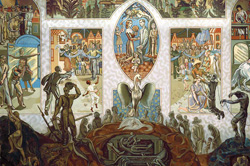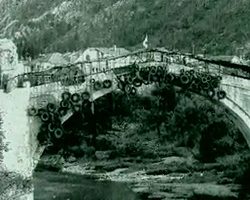Marina Abramović
Count on US
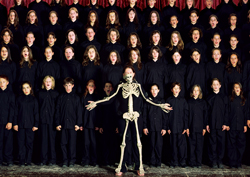 “After the long war period the Balkan countries were left with a completely destroyed infrastructure, economic problems and false promises.The work was made after I revisited the country in 2003 and was confronted with the present situation.” (M. Abramović) The original installation ‘Count on Us’ includes five videos all projected in one room. Being highly associative in terms of its content, it refers to various issues that could be placed in a concrete political context, as for example the Kosovo war. According to Abramovic, the work is mostly to be considered an emotional response to political events, which indicates that she somehow tries to avoid a specific political narrative. More
“After the long war period the Balkan countries were left with a completely destroyed infrastructure, economic problems and false promises.The work was made after I revisited the country in 2003 and was confronted with the present situation.” (M. Abramović) The original installation ‘Count on Us’ includes five videos all projected in one room. Being highly associative in terms of its content, it refers to various issues that could be placed in a concrete political context, as for example the Kosovo war. According to Abramovic, the work is mostly to be considered an emotional response to political events, which indicates that she somehow tries to avoid a specific political narrative. More
Abbas Akhavan
Study for Blue Shield
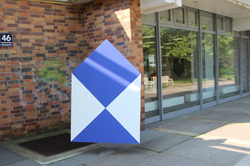 Akhavan’s work builds upon a tradition of painting that resides precariously between abstraction and representation, transgression into installation. Jasper Johns comes into mind as a godfather of this tradition. Johns’ Flag series, begun in 1954, represented a paradoxical departure within the abstraction movement where the works’ composition is a representational depiction of something abstract: in Johns’ case a set of geometric shapes representative of America. But in the same year, while Johns was concerning himself with representations of the nation-state, another symbol was created in The Hague to represent an international body. The International Committee of the Blue Shield is the cultural equivalent of the Red Cross. Like classical abstraction, its symbol sought—and still seeks—to speak a universal language. More
Akhavan’s work builds upon a tradition of painting that resides precariously between abstraction and representation, transgression into installation. Jasper Johns comes into mind as a godfather of this tradition. Johns’ Flag series, begun in 1954, represented a paradoxical departure within the abstraction movement where the works’ composition is a representational depiction of something abstract: in Johns’ case a set of geometric shapes representative of America. But in the same year, while Johns was concerning himself with representations of the nation-state, another symbol was created in The Hague to represent an international body. The International Committee of the Blue Shield is the cultural equivalent of the Red Cross. Like classical abstraction, its symbol sought—and still seeks—to speak a universal language. More
Alfred Banze
H. O. P. E.
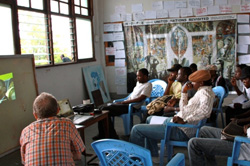 Berlin based artist Alfred Banze took an image of Per Krogh’s painting on a trip to Thailand, Indonesia, Congo and other places. This image became a catalyst of international artist workshops, where the imagery and the role of the UN in these countries were reflected. More
Berlin based artist Alfred Banze took an image of Per Krogh’s painting on a trip to Thailand, Indonesia, Congo and other places. This image became a catalyst of international artist workshops, where the imagery and the role of the UN in these countries were reflected. More
Vitshois Mwilambwe Bondo
UniManipulation, Corps d’un Congo malade
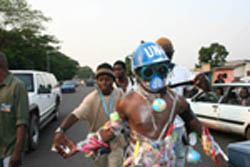 Vitshois Mwilambwe Bondo works in Congo, a country with a tiresome history of colonization and of peace initiatives of the United Nations. In Kinshasa he belongs to an art collective of young thinkers who tried to come to terms with the new and chaotic society of Congo. All the attempts are articulated around a concept which is called – the librisme. It is a movement of young revolutionary thinking artists in the Democratic Republic of Congo and other countries of the African continent showing opposition to colonial school academic art. Being invited to Strasbourg and Amsterdam Bondo’s work investigates questions dialogues between Western and African cultures. More
Vitshois Mwilambwe Bondo works in Congo, a country with a tiresome history of colonization and of peace initiatives of the United Nations. In Kinshasa he belongs to an art collective of young thinkers who tried to come to terms with the new and chaotic society of Congo. All the attempts are articulated around a concept which is called – the librisme. It is a movement of young revolutionary thinking artists in the Democratic Republic of Congo and other countries of the African continent showing opposition to colonial school academic art. Being invited to Strasbourg and Amsterdam Bondo’s work investigates questions dialogues between Western and African cultures. More
Hermann Josef Hack
Climate Refugee Camp
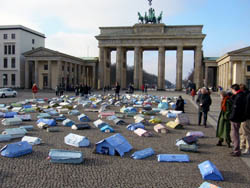 Among Hermann Josef Hack’s teachers was Joseph Beuys. Maybe it was he who triggered Hack’s life-long artistic interventions in the political world. Sometimes he even carried official titles like “Commissioner for Culture” for the Ministry of Science and Technology. He was a member of the founding committee of the Art and Exhibition Hall of the Federal Republic of Germany. His Global Brainstorming Project serves as an umbrella for all of his activities and projects. Hack’s artistic work is about communication and the development of new forms of communication. Since 2007 he has been working on the Climate Refugee Camp, which at the moment in on tour with Adrienne Göhler’s exhibition “Zur Nachahmung empfohlen” (“Imitation recommended”). More
Among Hermann Josef Hack’s teachers was Joseph Beuys. Maybe it was he who triggered Hack’s life-long artistic interventions in the political world. Sometimes he even carried official titles like “Commissioner for Culture” for the Ministry of Science and Technology. He was a member of the founding committee of the Art and Exhibition Hall of the Federal Republic of Germany. His Global Brainstorming Project serves as an umbrella for all of his activities and projects. Hack’s artistic work is about communication and the development of new forms of communication. Since 2007 he has been working on the Climate Refugee Camp, which at the moment in on tour with Adrienne Göhler’s exhibition “Zur Nachahmung empfohlen” (“Imitation recommended”). More
Barbara Hepworth
Single Form
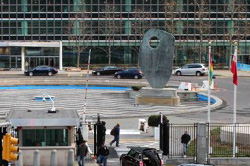 Single Form is Hepworth’s largest work and her most significant public commission. It stands in the United Nations Plaza in New York. Hepworth was a friend of the United Nations’ Secretary General Dag Hammarskjöld, who admired and collected her work. Single Form was commissioned by the Jacob and Hilda Blaustein Foundation as a memorial to Hammarskjöld after his tragic death in an air crash in 1961. More
Single Form is Hepworth’s largest work and her most significant public commission. It stands in the United Nations Plaza in New York. Hepworth was a friend of the United Nations’ Secretary General Dag Hammarskjöld, who admired and collected her work. Single Form was commissioned by the Jacob and Hilda Blaustein Foundation as a memorial to Hammarskjöld after his tragic death in an air crash in 1961. More
Sibylle Hofter
UNIC-UN information office Cairo (22) 2011
 Sibylle Hofter photographies show the pictures in between the pictures. This can be seen in her impressionable series on the UN Women Conference in Cairo. Sibylle Hofter runs the picture agency Schwimmer in Berlin.
Sibylle Hofter photographies show the pictures in between the pictures. This can be seen in her impressionable series on the UN Women Conference in Cairo. Sibylle Hofter runs the picture agency Schwimmer in Berlin.
Alfredo Jaar
Kigali
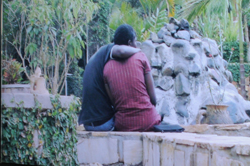 “Kigali” by Alfredo Jaar, 2008. (photo: Steffen Haug)
“Kigali” by Alfredo Jaar, 2008. (photo: Steffen Haug)
The work is the result of an invitation extended to Jaar to build a monument in Kigali to the victims of the genocide.
Video, 2008.
Khaled Jarrar
Concrete
 In August 2012, Khaled Jarrar started with his latest project ‘Up-cycle the Wall!’ – consisting of the film Concrete (2012), an ongoing series of objects, a website, and – in a next step – the activation and participation of the public in his production process. Living and working in Ramallah, Palestine, the artist deals in this new project with the effect of the occupation on the everyday life, especially with the impact of the wall. More
In August 2012, Khaled Jarrar started with his latest project ‘Up-cycle the Wall!’ – consisting of the film Concrete (2012), an ongoing series of objects, a website, and – in a next step – the activation and participation of the public in his production process. Living and working in Ramallah, Palestine, the artist deals in this new project with the effect of the occupation on the everyday life, especially with the impact of the wall. More
Sven Kalden
Palpatine am Platz der Vereinten Nationen
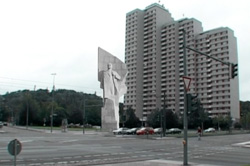 Kalden’s installation “Palpetine at the Place of the United Nations” is an attempt to re-work and condense the symbolic load at a public space that was till 1992 dominated by a monstrous Lenin sculpture. The sculpture was demounted and the place renamed. The public gardening office took charge of the redecoration of the place and placed five boulders for the five continents as a symbolical bow to the UN. Kalden takes the popular approach to political symbolism one step further by introducing the pop-culture character Chancellor Palpatine of Star Wars. His infamous “I love democracy, I love the republic“- speech resonates the double speak of totalitarian regimes that left their marks in the city since 1933. The small scale fountain may be a hint to the powerlessness of the UN. More
Kalden’s installation “Palpetine at the Place of the United Nations” is an attempt to re-work and condense the symbolic load at a public space that was till 1992 dominated by a monstrous Lenin sculpture. The sculpture was demounted and the place renamed. The public gardening office took charge of the redecoration of the place and placed five boulders for the five continents as a symbolical bow to the UN. Kalden takes the popular approach to political symbolism one step further by introducing the pop-culture character Chancellor Palpatine of Star Wars. His infamous “I love democracy, I love the republic“- speech resonates the double speak of totalitarian regimes that left their marks in the city since 1933. The small scale fountain may be a hint to the powerlessness of the UN. More
Per Krohg
n.t.
Per Krohg’s mural is placed as a backdrop in the room oft he UN Security Council. It is a present of Norway like the rest of the room’s interior. More.
Thomas Locher
“Human Rights”
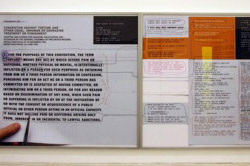 Thomas Lochers series „Human Rights“ is based on certain articles of the Human Rights Convention on torture and genocide. They focus on the unconditional nature of the vindication of those rights, on the right to the legal power of the individual, and on the principle of equality, especially with respect to the law. The underlining, questions and additional notes added by hand comment on the original texts, underscoring the deficiencies of Human Rights: the discrepancy between the juridical subject of Modernism, and man as such; of the naked individual, incompatible with any aspiration to universality. More
Thomas Lochers series „Human Rights“ is based on certain articles of the Human Rights Convention on torture and genocide. They focus on the unconditional nature of the vindication of those rights, on the right to the legal power of the individual, and on the principle of equality, especially with respect to the law. The underlining, questions and additional notes added by hand comment on the original texts, underscoring the deficiencies of Human Rights: the discrepancy between the juridical subject of Modernism, and man as such; of the naked individual, incompatible with any aspiration to universality. More
Goshka Macuga
“The Nature of the Beast”
Installation Whitechappel Gallery, London
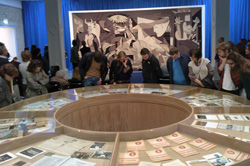 Macuga’s installation centers on the afterlife of Guernica in the political imagination. Draping a blue curtain behind the tapestry and displaying photographs and press clippings about “the case for war” in the circular table in the middle of the room makes that association clear. More
Macuga’s installation centers on the afterlife of Guernica in the political imagination. Draping a blue curtain behind the tapestry and displaying photographs and press clippings about “the case for war” in the circular table in the middle of the room makes that association clear. More
Kofi Setordij
Genocide Monument
 When Kofi Setordij saw the television images of a bulldozer shoveling hundreds of bodies into a ditch in Rwanda in 1994, as if they were no more than waste, he decided it was time to do something. He considered it his duty as an artist to show the world what had happened in Rwanda. When it became apparent to him that nobody seemed to remember what had taken place, only four years after the mass murder among the Tutsi population, he took action. More
When Kofi Setordij saw the television images of a bulldozer shoveling hundreds of bodies into a ditch in Rwanda in 1994, as if they were no more than waste, he decided it was time to do something. He considered it his duty as an artist to show the world what had happened in Rwanda. When it became apparent to him that nobody seemed to remember what had taken place, only four years after the mass murder among the Tutsi population, he took action. More
Ivar Smedstad
Bosnia
Bosnia is an audiovisual collage made of images collected from Newsweek magazine during the war in Bosnia and Herzegovina.
The bridge of Mostar becomes a metaphor for the destruction of war as the images of the collapse, and the people behind it, are morphed together creating a pastiche of sound and image in the form of a time based sculpture. More.
Guy Wouete
Codes
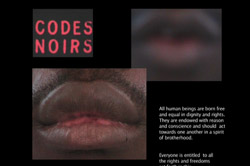 In „Codes …“ Woute confronts the history of the Western tradition of Human Rights with a historical monstrosity. “La déclaration des droits de l’homme et du citoyen“ form 1789 has become one of the founding codices of Human Rights politics. But it stands, so Woute suggests, back to back with the “Code Noire” of Lois XIV from 1685, regulating the legal status of blacks, i. e. the justification of slavery. Officially abandoned in 1794 it was upheld until 1848. More.
In „Codes …“ Woute confronts the history of the Western tradition of Human Rights with a historical monstrosity. “La déclaration des droits de l’homme et du citoyen“ form 1789 has become one of the founding codices of Human Rights politics. But it stands, so Woute suggests, back to back with the “Code Noire” of Lois XIV from 1685, regulating the legal status of blacks, i. e. the justification of slavery. Officially abandoned in 1794 it was upheld until 1848. More.
Zentrum für politische Schönheit
Pillar of shame
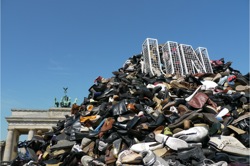 The Center of Political Beauty is an art collective that uses public performances to propose a “aggressive humanism.” Genocide, arms trade, the alienation of politicians and the public, the failed peace on the Balkans: Philip Ruch and his co-workers don’t shy away from hurtful topics. In its own words the Center is a think tank for moral beauty, for political poetics and for human high-mindedness. In 1995, 8,000 people died in the UN safe-haven of Sebrenica. In public performances and a feature film “The Sky over Sebrenica” the Center reveals the plight of the 40,000 besieged civilians and the failure of decision makers to come to their help. The Pillar of Shame collected more than 16,000 Bosnian shoes in front of the Brandenburg Gate in remembrance of the victims. More.
The Center of Political Beauty is an art collective that uses public performances to propose a “aggressive humanism.” Genocide, arms trade, the alienation of politicians and the public, the failed peace on the Balkans: Philip Ruch and his co-workers don’t shy away from hurtful topics. In its own words the Center is a think tank for moral beauty, for political poetics and for human high-mindedness. In 1995, 8,000 people died in the UN safe-haven of Sebrenica. In public performances and a feature film “The Sky over Sebrenica” the Center reveals the plight of the 40,000 besieged civilians and the failure of decision makers to come to their help. The Pillar of Shame collected more than 16,000 Bosnian shoes in front of the Brandenburg Gate in remembrance of the victims. More.







